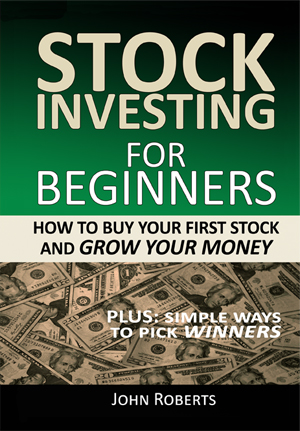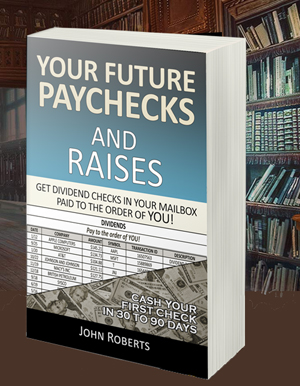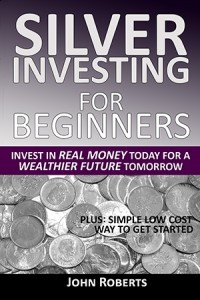ETFs – How To Use This Book
Coming Soon! Look for my new book Exchange Traded Funds Investing For Beginners – How To Buy Your First ETF And Grow Your Money. Below is a free sample chapter and preview for you.
~~~~~
How To Use This Book
As you read though this book, you’ll see how simple it is to start building your ETF investments. And how you are just a few steps away from buying your first ETF. So with that in mind, here’s what you’ll learn about these exciting investments.
Section 1 is what you are reading now. It’s an “Introduction.” We’ll introduce one of the key advantages to ETFs, And that is to reduce your investment risk through diversification. And ETFs have diversification built right into them. And they many other advantages as well. Like how you can increase and preserve your wealth over time with ETFs.
Then in Section 2 we answer the important question, “What Is An Exchange Traded Fund (ETF)?” I think you’re going to like this new investing avenue they provide you. Indeed, they were first created for the big boys back in the 1990;s. But they rapidly became more popular, and are now used by thousands of investors like you and me.
Then in Section 3 we answer the important question, “Why Invest In ETFs?” I think you will be surprised at some of the reasons. Some that you may not have thought about. For example, they let you tap into expertise of investments that are complex, without having to get into the complex details.
And they provide an enormous variety of choices. Now most people will invest in Stock or Bond ETFs. But there are Commodity ETFs, Sector ETFs, International, Dividends and even Stock Options if you want to get into that.
And most of them have low expenses – so that expertise doesn’t cost you much. Also they are quite visible – so you can always see a list of the many stocks, or bonds, etc. your fund is invested in. That’s unlike some mutual funds, where the investments are hidden away and not disclosed.
Section 4 is called “Basic Information About ETFs.” And we really mean basic information here — just what you need to know to get started. We’ll introduce you to some of the big players who provide ETFs you will want to invest in. And how ETFs are different from other funds. And what’s up with that “Exchange Traded: name. It sounds complicated, but it’s really not.
Then in Section 5 we get into “The Different Types Of ETFs.” We start with the most common ones, and those are stock ETFs. These are by far the most invested in. Then bond funds come next. But there are other interesting types of ETFs you may wish to invest in also.
They include Commodity ETFs, Sector ETFs, International, Dividends and even Stock Options if you want to get into that. Some of them even pay you dividends while you own them. And we get into those too.
Section 6 is called “What You Need To Get Started.” You really only need one thing to get started. And that’s a stock market account. Just like you need a checking account to hold your money and do your banking, you need a stock market account to hold your stocks and do your investing. See there, we did it again, didn’t we. We started with something you know – a checking account. And then we related it to a stock market account.
We’ll tell you how you can open a stock market account. And once you’ve done this, you’re one click away from getting started. You can open your stock market account with a single phone call to a broker. And they will be happy to help you set it up. And I’ll even tell you which online broker I have used successfully for years.
Here’s the other good news. You only need to do this once. Then you’re good to go.
Section 7 is called “How To Buy ETFs.” Okay, you’ll be surprised how easy this can be. If you are currently buying stocks in your trading account, spoiler alert, you buy an ETF just like you buy a stock. And an ETF even has a stock symbol, just like a stock, that you use to buy it.
Then in Section 8 we get into “How Many ETFs Should You Own.” There’s a wide range of opinions on this from the experts. But we start with a single ETF, and then add a few from there. And you’ll see a number of different portfolios that we examine.
Section 9 is called “Protecting Your ETF Investments.”
This is mainly about when to sell. And it is the hardest question in investing. Not knowing when to sell causes people to take big losses in the stock market. Perhaps you have experienced this as well. But do you know that there is a simple technique that will keep you from having big losses? If you do this, you will be way ahead of most investors.
It’s a simple, effective and important technique. We use it because, historically, over time, the stock market tends to go up, and your wealth increases. But it doesn’t go up in a straight line. Sometimes the market and stocks go down for a while. Like the investors and employees at ENRON experienced. Had they used this one technique, and another one we show you as well, they would not have suffered catastrophic losses where most of them got completely wiped out!
But you can protect against this. And we’ll show you how.
Then we wrap up in the Conclusion Section with “Additional Resources,” useful to you as a new ETF investor. We cover a number of helpful resources in the book. So this section lists them all for you as a handy reference. And some additional resources are listed as well.
Finally, writing this book has been most gratifying, because I know that many of you can make money with ETF investing over time, and protect your investments from the ravages of inflation too.
So I’m excited for you… as you begin building your ETF investments today for a wealthier future tomorrow.
~~~~~
So that’s the preview. The book will be released in just a couple of months. In the meantime, you might be interested in my book Stock Investing for Beginners – How To Buy Your First Stock And Grow Your Money. It’s been well received, with over 2000 5-Star reader reviews.
Here’s what one reader had to say…
I FINALLY understand stocks!! - 5 Stars
This book is a work of genius!!! I tried to get into stocks years ago and none of the references for beginners I came across made any sense, so I gave up. I decided to give it another try and some references captured the very basics like “what is a stock?” “why is investing important?” but after that sent me for a loop again.
I decided not to give up again and that’s what led me to this book. John Roberts simplifies EVERYTHING! He puts in a relative perspective so you can understand it better. Like saying an exchange is basically an auction. He relates something unfamiliar to something familiar so you can grasp it better. It helps a lot to be put this way.
And I love that he centers the book solely on stocks. Other references start throwing in bonds and funds when you barely understood stocks to begin with, making you twice as confused.
I also love that he reiterates some important points because sometimes I’ll forget something and wind up going back and try to read it again, but he brings up the points again to make it easier to stick. And being new to the stock market I need that reminder.
Upon reading this book, I was finally able to get a stockbroker account and begin investing with confidence. Something I never thought I could do. I can’t wait to read his other books!” – I. Espinosa
Many thanks for their good review, and if it piqued your interest, you can view Stock Investing For Beginners for free right here.
All the best – John Roberts



